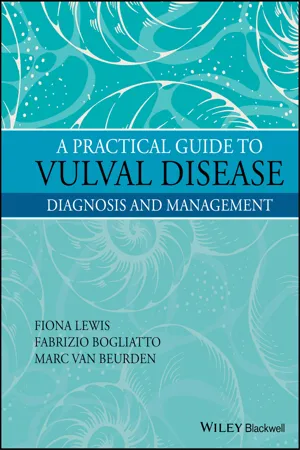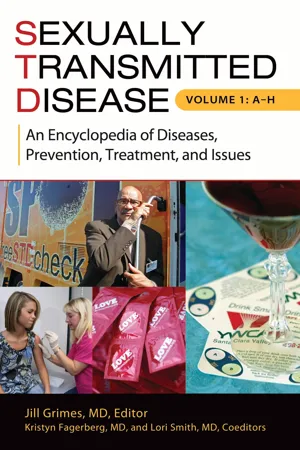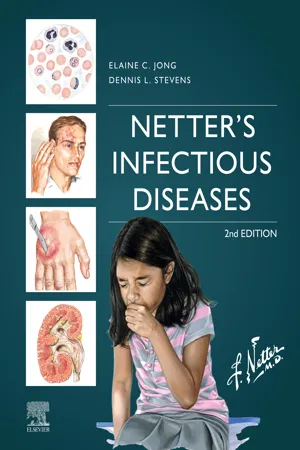Biological Sciences
Trichomoniasis
Trichomoniasis is a sexually transmitted infection caused by the parasite Trichomonas vaginalis. It commonly affects the urogenital tract in both men and women, leading to symptoms such as vaginal discharge, itching, and discomfort during urination. While it can be treated with antibiotics, trichomoniasis can lead to serious complications if left untreated, making early detection and treatment crucial.
Written by Perlego with AI-assistance
Related key terms
Related key terms
1 of 4
Related key terms
1 of 3
9 Key excerpts on "Trichomoniasis"
- eBook - ePub
- Lynne Shore Garcia(Author)
- 2016(Publication Date)
- ASM Press(Publisher)
25 Protozoa from Other Body Sites Trichomonas vaginalis Toxoplasma gondii Trichomonas vaginalisTrichomonas vaginalis was first isolated in 1836 from the purulent discharge from female genital organs. The infection occurs worldwide and has been found in the population whenever the appropriate specimens have been examined for the presence of the organism. It is estimated that 5 million women and 1 million men in the United States have Trichomoniasis, with the annual incidence of new cases estimated at 7.4 million (1 ). The annual incidence of Trichomoniasis worldwide is estimated to be more than 275 million cases, which does not include the number of asymptomatic cases that are not treated. In North America, more than 8 million new cases are reported yearly, with an estimated rate of asymptomatic cases being as high as 50% (1 ). Trichomoniasis is now the primary nonviral sexually transmitted infection (STI) worldwide. In women, disease manifestations may include vaginitis, cervicitis, urethritis, pelvic inflammatory disease, and adverse birth outcomes. T. vaginalis infection may also increase risk of HIV transmission, the incidence and severity of cervical and prostate cancer, and increased infertility. Some of the most recent developments in our understanding of T. vaginalis pathobiology include the increased association with HIV in terms of exposure to STIs and a positive association with aggressive prostate cancers (2 ).Population genetic analysis has shown that T. vaginalis is a genetically diverse parasite that consists of two types present in equal proportions worldwide. Parasites belonging to the two types (type 1 and type 2) differ significantly in the rate at which they harbor the T. vaginalis virus, a double-stranded RNA virus implicated in parasite pathogenesis, and in their sensitivity to the widely used drug metronidazole (3 ). The extensive clinical variability and disease sequelae are matched by significant genetic diversity in the organism itself; this strongly suggests a connection between the genetic identity of isolates and their clinical manifestations (4 - eBook - ePub
A Practical Guide to Vulval Disease
Diagnosis and Management
- Fiona M. Lewis, Fabrizio Bogliatto, Marc van Beurden(Authors)
- 2017(Publication Date)
- Wiley-Blackwell(Publisher)
Trichomoniasis is a common sexually transmitted infection with over 3 million people infected in the United States each year. It can be associated with prematurity and low birth weight if it occurs during pregnancy. There is also a link with HIV infection and Trichomoniasis may increase the risk of transmission of HIV.Pathophysiology
The causative organism is the protozoan Trichomonas vaginalis. It is found in the vagina but 90% of infected women have urethral infection.Clinical features
The main symptom is a vaginal discharge which may be malodorous. Dysuria and vulval pruritus are also common. However, up to 50% of patients do not report any symptoms. The discharge is typically foamy but can vary in type and a ’strawberry’ like appearance is seen on the cervix. Vestibular erythema and posterior vulvitis is seen secondary to the vaginal discharge.Diagnosis
The diagnosis can be made by direct microscopy of a wet preparation as the motile organisms are easily seen. The infection can then be confirmed on culture. Several nucleic acid amplification tests are now used, and these are regarded as the most sensitive tests.Basic management
The treatment is a single dose of 2 g of metronidazole. The patient should be referred to a genito‐urinary clinic for contact tracing and screening for other STIs.Further reading
- Forna, F. and Gulmezoglu, A. M. (2003) Interventions for treating Trichomoniasis in women. Cochrane Database of Systematic Reviews2
- eBook - ePub
Sexually Transmitted Disease
An Encyclopedia of Diseases, Prevention, Treatment, and Issues [2 volumes]
- Jill Ann Grimes MD, Lori Apffel Smith MD, Kristyn Fagerberg MD, Jill Ann Grimes MD, Lori Apffel Smith MD, Kristyn Fagerberg MD, Jill Ann Grimes MD, Lori Apffel Smith MD, Kristyn Fagerberg MD(Authors)
- 2013(Publication Date)
- Greenwood(Publisher)
Trichomonal infections can be passed from partner to partner by direct genital contact. Trich infections are the only sexually transmitted infections (STIs) that are passed through neither oral nor anal sex. Transmission is, therefore, most often from heterosexual genital intercourse or through sharing sex toys between two or more females. Latex condoms greatly decrease the transmission of trichomonas, though obviously not when there is failure of the condom via breakage or improper use. Trichomonas cannot be passed by kissing, hugging, or other casual contact, nor is it transmitted in public restrooms, hot tubs, swimming pools, or bed linens. While trichomonas can remain viable in moist areas such as damp towels or underwear, transmission resulting in infection has not ever been documented.Photomicrograph of a wet-mounted vaginal discharge specimen reveals numbers of Trichomonas vaginalis protozoan parasites, leading to a diagnosis of Trichomoniasis, or “trich,” which is a very common STD that is caused by infection with T. vaginalis . Although symptoms of the disease vary, most women and men who have the parasite cannot tell they are infected.(Centers for Disease Control and Prevention)What are the symptoms of trichomonal infection?
Trich can infect both males and females, but 90 percent of male infections are completely asymptomatic —the men are totally unaware of any symptoms. For the 10 percent of men who do notice a problem, the most common complaints are a discharge from their urethra and pain with urination or ejaculation. In women, the symptoms often come and go over weeks, months, or even years. Burning or discomfort with urination, a light yellow or green frothy vaginal discharge, or a bad odor (from the discharge) can signal the presence of trich. Another common female symptom may be simply the new onset of pain or discomfort during sex—with or without any of the other complaints.Because the symptoms can wax and wane, or even disappear without treatment, trichomonal infections can and often do persist for a great deal of time. Women with trich infections that show up as a vaginal discharge may assume they have a vaginal yeast infection. After using an over-the-counter product for several days, the discharge and irritation seem to resolve, which further confirms to that individual that she did, indeed, have a yeast infection, which is now treated and gone. However, all that has really happened is that, following the natural history of trich infections, women may notice a discharge, discomfort, and odor for several days to a week, and then the symptoms fade, but the infection persists. Weeks later, the symptoms recur, but people may not connect the dots to realize it is the same infection. - Sarah J. Pitt(Author)
- 2017(Publication Date)
- Wiley-Blackwell(Publisher)
Infection has also been associated with male infertility because it might affect sperm function (Lewis, 2014). While the overwhelming majority of patients who present with symptoms are female (Lewis, 2014), males can experience severe consequences. Although it is extremely rare, damage due to chronic T. vaginalis infection has been reported to be the cause of genital ulcers and tissue damage in males (e.g., Gosnell et al., 2015). 6.5.3 Epidemiology Most cases are asymptomatic and screening for prevalence is not routinely carried out, so available data about the number of cases Trichomoniasis are very much estimates. Another problem is the relatively low sensitivity of the wet preparation, which is the most widely used diagnostic test (Mielczarek and Blaszkowska, 2015). Nevertheless, it is thought that global prevalence may be up to 20% in females and 10% in males (Mielczarek and Blaszkowska, 2015), with an incidence of over 270 million each year (Lewis, 2014). Rates of infection in the UK are considered to be low, but, for example, over 6,000 cases are diagnosed in England each year (Lewis, 2014; Hathorn et al., 2015), which is probably an underestimate for the reasons outlined above. Point to consider 6.8: What are the public health considerations for control and monitoring of an infection where most of the cases are asymptomatic? 6.5.4 Laboratory Diagnosis Microscopic examination of a wet preparation from the genital swab is the most commonly used diagnostic method. It is a simple and rapid test, but its sensitivity can be as low as 50% (SMI B28, 2014). This is likely to be due to a combination of factors, including time between specimen collection and examination (searching for a trophozoite amongst epithelial cells is always easier when the parasite is alive and active) and – where there is a delay – mode of specimen transport to the laboratory, as well as low parasite shedding rates- eBook - ePub
- William J. Ledger, Steven S. Witkin(Authors)
- 2017(Publication Date)
- CRC Press(Publisher)
3 MICROBIOLOGYTrichomonas vaginalis is a flagellated, singlecell, eukaryotic, protozoan parasite that resides extracellularly in the human female lower genital tract and the male urethra. Following its sexual transmission, the free swimming trophozoite form undergoes a morphological transition to an amoeboid form that strongly adheres to epithelial cells. T. vaginalis infection is the leading nonviral sexually transmitted infection worldwide. Its prevalence has been estimated to approach that of Chlamydia trachomatis, Neisseria gonorrhoeae, and syphilis combined.4 This is probably an under-estimate since at least one-third of T. vaginalis infections in women and most infections in men are without distinguishing symptoms. In symptomatic women, T. vaginalis is a common cause of mucopurulent cervicitis and vaginitis.5 There is no relation between the number of organisms present in the vagina and clinical signs and symptoms. This indicates that individual host immune and genetic factors, as well as the composition of the vaginal microbiota, influence the consequences of a T. vaginalis infection.The genome of T. vaginalis is highly unusual.6 The organism is haploid and has six chromosomes. Its DNA content (approximately 160 MB) is much higher than that of other unicellular parasites. Another unique attribute of T. vaginalis DNA is that one-fourth of the genome is composed of repetitive sequences that apparently do not code for any proteins. There are two major subtypes of T. vaginalis, TV1 and TV2,7 based upon genome diversity. Surprisingly, T. vaginalis appears to be most closely related to parasites found in birds,8 suggesting that, in times past, it jumped from birds to humans. The organism also does not have mitochondria and instead contains a structure called a hydrogenosome.9 - eBook - ePub
- Elaine C. Jong, Dennis L. Stevens(Authors)
- 2021(Publication Date)
- Elsevier(Publisher)
vaginalis include more than one sex partner in the previous year, having less than a high school education, living below the poverty level, having a history of incarceration, and HIV infection. The prevalence of T. vaginalis infection, unlike that of many other STIs, is higher among older women. In contrast, data from the National Health and Nutrition Examination Survey (NHANES), a population-based study, found the T. vaginalis prevalence among men to be far lower than that among women (<1%), and the rate did not vary by age. Whether this sex difference is real or due to a detection bias as a result of the lack of general screening, biologic reasons, or other factors is unknown. T. vaginalis is uncommon in men who have sex with men. Etiology/Pathophysiology T. vaginalis is a unicellular flagellate parasite that primarily infects the squamous epithelium of the genital tract by adhering to the epithelial cells and obtaining nutrients by lysing the cells. T. vaginalis can harbor two Mycoplasma species (M. hominis and M. girerdii), which may be linked to persistent infection. It can also harbor a T. vaginalis virus (TVV). This is a double-stranded RNA (dsRNA) virus, of which there are four types (TVV1–TVV4). The presence of TVV2 has been linked to more severe genital symptoms in some studies but not others. T. vaginalis infects the female lower genital tract (vagina, urethra, and endocervix) and the male urethra and prostate, where it replicates by binary fission and causes inflammation. Infection with T. vaginalis has been linked to a greater likelihood of both the transmission and acquisition of HIV, largely due to inflammation and recruitment of target CD4 cells. T. vaginalis is transmitted among humans, its only known host, primarily by sexual intercourse, including digital-vaginal manipulation and mutual masturbation where there is exchange of genital fluids. T. vaginalis has been found in the oral cavity and in the rectum - eBook - ePub
Child Abuse and Neglect E-Book
Diagnosis, Treatment and Evidence
- Carole Jenny(Author)
- 2010(Publication Date)
- Saunders(Publisher)
46Treatment includes observation alone or mechanical destruction of lesions using methods such as curettage or cryotherapy, or topical application of cytotoxic agents such as cantharidin, retinoic acid, or podophyllin.49Trichomonas Vaginalis (TV)
Trichomonas vaginalis is a flagellated protozoa that can be identified microscopically by its undulating membrane. It is a common sexually transmitted disease. The U.S. Centers for Disease Control estimates that 7.4 million new cases occur in the United States each year.50 Unlike gonorrhea and chlamydia, TV’s incidence appears to increase in middle-aged women.51 Factors that may increase the chance of acquiring the disease include: increased number of sexual partners, adolescents whose partner is older by 4 or more years, and the presence of other sexually transmitted diseases.52Trichomoniasis is a self-limited disease in less than 40% of men and less than 20% of women, where recovery occurs without treatment. The presence of a TV infection increases the risk of contracting HIV in women53 and increases the shedding of HIV in semen of men.54Transmission is primarily by sexual contact.55 TV has been demonstrated to be viable on inanimate objects (e.g,. for 45 minutes on toilet seats56 and up to 25 hours on damp towels57 ). The relationship between its presence and the risk of acquiring an infection from that source, however, is not well studied. Transmission can also occur during delivery, with disease being found in infants of infected mothers between 2% and 17% of the time.50 Incubation ranges from 5 to 28 days. There is some indication that the prepubertal patient might be less likely to become infected after contact with the organism because of the high vaginal pH and lack of secretions in the vagina of the child.58 - eBook - ePub
- Elizabeth A. Layden, Andrew Thomson, Philip Owen, Mayank Madhra, Brian A. Magowan(Authors)
- 2022(Publication Date)
- Elsevier(Publisher)
Candida are pregnancy, diabetes, immunosuppression, antimicrobial therapy and vulval irritation/trauma. It is not sexually acquired; thus, sexual partners do not need to be treated.Diagnosis
Microscopy and culture is the most sensitive method of diagnosis. However, in many cases, syndromic management without testing is appropriate. The sensitivity of clinical diagnosis increases with the number of symptoms and signs present. Up to half of women who self-diagnose candidal infection have another condition.Treatment
Azole antifungals are widely used for treatment:- • oral fluconazole 150 mg single dose (oral azoles are contraindicated in pregnancy)
- • clotrimazole pessaries for 1, 3 or 6 nights.
Complications
There are no known long-term complications from candidal infections.Trichomonas Vaginalis
Background Information
TV is uncommon in the United Kingdom. However, in other parts of the world – for example, Africa and Asia – it remains a major cause of vaginal discharge. It is sexually transmitted and infects only the urogenital tract. It may be asymptomatic in 10% to 50% of women but can cause significant vulval and vaginal inflammation.Treatment
The recommended treatment is:- • metronidazole 2 g single oral dose, or
- • metronidazole 400 mg orally twice daily for 5 to 7 days.
Complications
TV increases a woman’s risk of acquiring HIV infection and in pregnancy is associated with low birth weight and pre-term delivery.Infections of the Cervix
Chlamydia Trachomatis
Background Information
C. trachomatis - eBook - ePub
- S. H. Gillespie(Author)
- 2014(Publication Date)
- Butterworth-Heinemann(Publisher)
Chlamydia trachomatis is an important pathogen of the genital tract in both men and women. Infection can result in nonspecific or non-gonococcal urethritis, cervicitis, or acute pelvic inflammatory disease, which may subsequently compromise fertility or predispose to ectopic pregnancy.Many organisms are implicated in disease of the genital tract, and some of these are summarized in Table 19.1 .Table 19.1 Pathogens implicated in infections of the genital tractOrganism Typical syndrome Protozoa Trichomonas vaginalis Vaginal discharge Fungi Candida albicans Vaginal discharge Bacteria Neisseria gonorrhoeae Vaginal discharge (often asymptomatic) Chlamydia trachomatis Discharge, pelvic inflammatory disease Mycoplasma hominis Pelvic inflammatory disease, post-partum fever Ureaplasma urealyticum Gardnerella vaginalis Vaginal discharge Mobiluncus spp. Haemophilus ducreyi Genital ulcer Treponema pallidum Syphilis (not cultivatable) Calymmatobacterium Genital ulcer disease donovani (not cultivatable) Treponema pallidumSyphilis
Introduction
Index pages curate the most relevant extracts from our library of academic textbooks. They’ve been created using an in-house natural language model (NLM), each adding context and meaning to key research topics.
Explore more topic indexes
Explore more topic indexes
1 of 6
Explore more topic indexes
1 of 4








